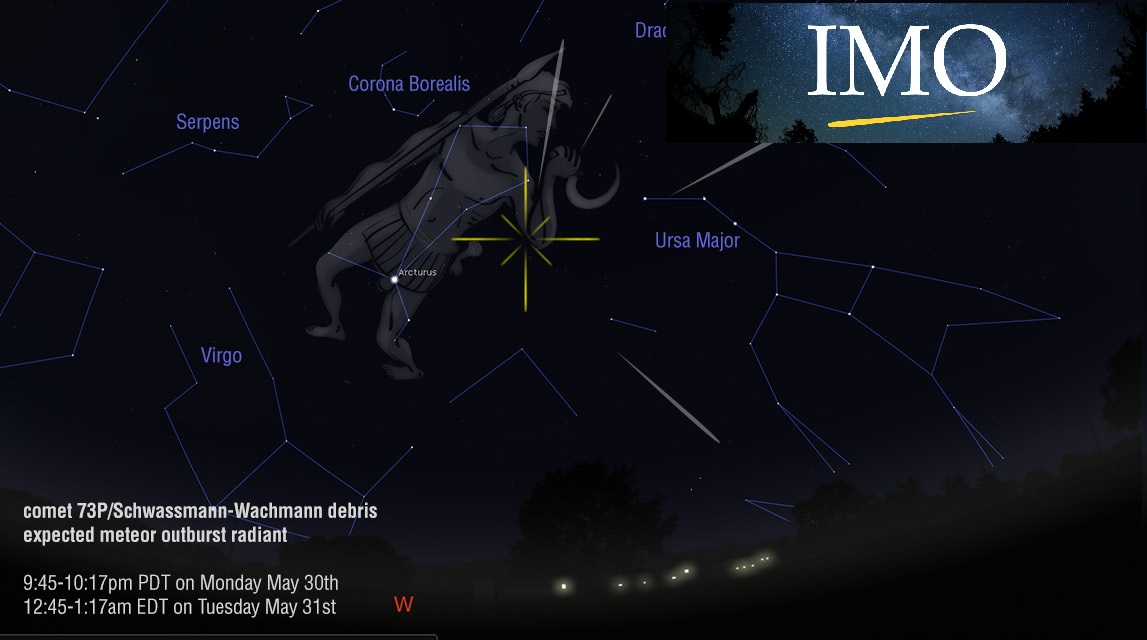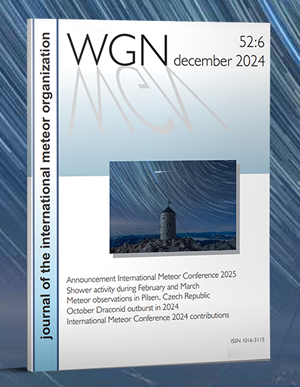
On the night of May 30/31, the Earth crosses the orbit of comet 73P/Schwassmann-Wachmann, also known as SW3. The comet itself will not be anywhere near the vicinity of the Earth but debris from a massive fragmentation event in 1995 may be there to light up our skies with meteors. SW3 will reach this point in August but meteor watchers are hopeful that the fragmentation event in 1995 sent debris ahead of the comet to be encountered by the Earth in May. Most debris ends up behind the comet forming the tail we see in bright comets. But if the velocity of the debris leaving the comet was high enough, some of this material could have also moved forward of the comet. Even if this comes to pass, we also need to hope that the debris is large enough to be visible from the ground. Most meteors we see are produced by tiny bits of rock, ice, or metal, no larger than a grain of sand. It is the tremendous velocity at which they strike that atmosphere that causes them to be visible while still high in the atmosphere. Unfortunately the debris from SW3 will be moving in the same general direction as the Earth, therefore these meteors will be toward the low end of the velocity scale. What this means is that the meteors entering the atmosphere from SW3 must be larger than normal in order to be seen from the ground.
So it sounds as if this display is highly unlikely. Possibly, but there have been meteor outbursts produced by slower than normal meteors in the past. The Bielids (Andromedids) of the 19th century and the Giacobinids (October Draconids) of the 20th century are example of meteors that were slower than normal that produced outbursts. So what do you need to know in order to try and see this possible outburst? First of all the Earth is predicted to encounter the debris from the 1995 event between 4:45-5:17 Universal Time on Tuesday May 31st. This corresponds to 12:45-1:17am EDT on Tuesday May 31st and 9:45-10:17pm PDT on Monday May 30th. The southwestern USA and Mexico are favored locations as the radiant, the area of the sky where these meteors come from, will be located highest in a dark sky. Alaska and Washington will be bathed in twilight at this time, ruining their chance of seeing anything. The same goes for the north and western Canadian provinces. The outburst may be seen from southeastern Canada and the remainder of the USA, but at a lower altitude. All of Central and South America can see this event, but the radiant will be low in the sky all but the northwest portion of South America.
The Earth will also cross two more debris fields produced by the 1892 and 1897 returns of this comet. These are predicted to occur at 16 UT on May 30th (favoring the western Pacific, Asia, and Oceania) and 10UT on the 31st (favoring western North America and the Eastern Pacific). These two debris fields are thought to be much less dense than the 1995 event, therefore little activity is expected from them.
No matter your location, the meteors will be shooting from the same location in the sky. This will NOT be from the faint star known as tau Herculis, which is why I am refraining from calling this shower the tau Herculids. Radiants from disruptive comets such as SW3 can be located in different portions of the sky year to year, depending on the location of the debris trail. The expected radiant for meteors from SW3 this year is located at the position of 13:56 (209) +28. This position is located in western Bootes, approximately 8 degrees northwest of the brilliant orange star known as Arcturus (alpha Bootis). This area of the sky is best placed near 22:00 (10pm) local daylight saving time, when it lies highest in the sky. It should be noted that the radiant is expected to be a large area of the sky and not a pinpoint. So any slow meteor from this general area of the sky can be expected to be from SW3. You need not look directly overhead as meteors may appear in any portion of the sky. They are actually more likely to appear at lower elevations in the sky since at these elevations one is looking through a far thicker slice of the atmosphere that when looking straight upwards.
If this display occurs, most of the meteors are expected to be faint. Therefore in order to see the most activity it is highly suggested that you observe from the darkest location possible. The more stars you can see, the more meteors you will see. You need at avoid city lights as much as possible. The moon will be new on May 30th so it will not interfere at all, which is most fortunate as it is easier to avoid light pollution compared to moonlight! Start your viewing session at least an hour prior to the time of the expect outburst, just in case the predictions are off. This will also allow your eyes to be fully adjusted to the dark surroundings. Try to avoid anything that will ruin your night vision such as flashlights and car headlights.
While it is fun just lying back and enjoying the scene, anyone can contribute scientifically useful data by counting the number of meteors seen during a specified period. We usually like to limit each period to 20 meteors or less so the length of each period depends on the activity. If activity is low then hour long periods are acceptable. If activity is high then you may wish to try and estimate the number of meteors visible each minute or fractions of a minute. Try to differentiate meteors from SW3 and those that come from another direction or have a faster velocity. Do not count satellites as they are totally unrelated to meteor and usually take several minutes to cross the sky. Meteor observations are accepted by the International Meteor Organization. Simply register (it’s free) or log in at www.imo.net and enter your data on their visual meteor observing form.
Predictions of brilliant comets and strong meteor outbursts are commonplace and usually end up being an non-event. This event may also be wishful thinking, giving those who publicize it another black eye. But we believe that this event has a chance of being something spectacular and that we would be remiss by not publicizing it. When viewing events such as these one should expect nothing extraordinary to happen, but certainly hope for the best!
References:




 You saw something bright and fast? Like a huge shooting star? Report it: it may be a fireball.
You saw something bright and fast? Like a huge shooting star? Report it: it may be a fireball.  You counted meteors last night? Share your results with us!
You counted meteors last night? Share your results with us!  You took a photo of a meteor or fireball? You have a screenshot of your cam? Share it with us!
You took a photo of a meteor or fireball? You have a screenshot of your cam? Share it with us!  You caught a meteor or fireball on video? Share your video with us!
You caught a meteor or fireball on video? Share your video with us!
One comment
Well-written, and in such a way that it needs no translation before the link to the article is passed on to the general public. Thank you!